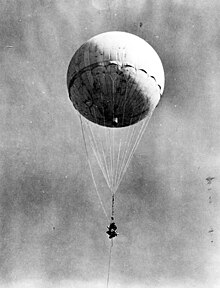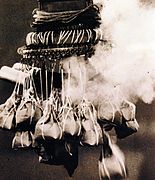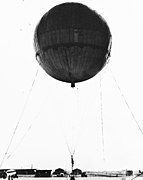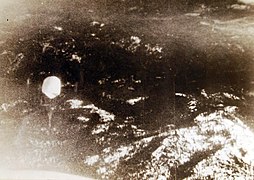avia.wikisort.org - Airship
Fu-Go (ふ号[兵器], fugō [heiki], lit. "Code Fu [Weapon]") was an incendiary balloon weapon (風船爆弾, fūsen bakudan, lit. "balloon bomb") deployed by Japan against the United States during World War II. A hydrogen balloon measuring 10 metres (33 ft) in diameter, it carried a payload of two 11-pound (5.0 kg) incendiary devices plus one 33-pound (15 kg) anti-personnel bomb (or alternatively one 26-pound (12 kg) incendiary bomb). It made use of high-altitude and high-speed air currents over the Pacific Ocean (today known as the jet stream), and was intended to start large forest fires.
Between November 1944 and April 1945, the Japanese launched about 9,300 balloons from sites on Honshu, of which about 300 were found or observed in the U.S., with some in Canada and Mexico.[1] Despite the high hopes of designers, who created a sophisticated ballast system to control altitude on the three-day flight, the balloon bombs were largely ineffective due to damp forest conditions and malfunctions, causing only six deaths (from a single civilian incident in Oregon) and minor damage.
The Fu-Go balloon was the first weapon to possess intercontinental range,[2] the second being the Convair B-36 Peacemaker and the third being the R-7 ICBM. The balloon attacks on North America were at the time the longest ranged attacks in the history of warfare, a record which was not broken until the 1982 Operation Black Buck raids during the Falkland Islands War.
Background
The balloon bomb concept was a brainchild of the Imperial Japanese Army's Number Nine Research Laboratory, also known as the Noborito Laboratory, founded in 1927.[3] In 1933, Lieutenant General Reikichi Tada began an experimental balloon bomb program at Noborito, designated Fu-Go,[lower-alpha 1] which proposed a hydrogen balloon 4 metres (13 ft) in diameter equipped with a time fuse and capable of delivering bombs up to 70 miles (110 km). The project was stopped by 1935 and never completed.[5]
After the Doolittle Raid in April 1942, in which American planes bombed the Japanese mainland, the Imperial General Headquarters directed Noborito to develop a retaliatory bombing capability against the U.S.[6] In summer 1942, Noborito investigated several proposals, including long-range bombers that could make one-way sorties from Japan to cities on the U.S. West Coast, and small bomb-laden seaplanes that could be launched from submarines.[7] On September 9, 1942, the latter was tested in the Lookout Air Raid, in which a Yokosuka E14Y seaplane was launched from a submarine off the Oregon coast. Warrant Officer Nobuo Fujita dropped two large incendiary bombs in Siskiyou National Forest in the hopes of starting a forest fire and safely returned to the submarine; however, response crews spotted the plane and contained the small blazes. The program was cancelled by the Navy.[8]
Also in September 1942, Major General Sueki Kusaba, who had served in the original balloon bomb program under Tada, was assigned to Noborito and revived the Fu-Go project with a focus on longer flights.[8] While the Oregon air raid had not achieved its strategic objectives, it had demonstrated the potential of using unmanned balloons at a lower cost and risk to ignite large-scale forest fires that could divert resources away from the U.S. war effort.[9]
Development
After months of research, Kusaba's team developed a six-metre (20 ft) prototype balloon capable of flying at 25,000 feet (7,600 m) for 30 hours.[10] The balloons were constructed from five thin layers of washi, a durable paper derived from the paper mulberry (kōzo) bush, which were glued together with konnyaku (Japanese potato) paste. The Army mobilized thousands of teenage girls at high schools across the country to laminate and glue the sheets together, with final assembly and inflation tests at large indoor arenas including the Nichigeki Music Hall and Ryōgoku Kokugikan sumo hall in Tokyo.[11] The original proposal called for night launches from submarines located 600 miles (970 km) off the U.S. coast, a distance the balloons could cover in 10 hours. A timer would release a five-kilogram (11 lb) incendiary bomb at the end of the flight.[12] Two submarines (I-34 and I-35) were prepared and two hundred balloons were produced by August 1943, but attack missions were postponed due the need for submarines as weapons and food transports.[10]
Nobibito next investigated the feasibility of balloon launches against the United States from the Japanese mainland, a distance of at least 6,000 miles (9,700 km).[11] Engineers sought to make use of strong seasonal air currents discovered flowing from west to east at high altitude and speed over Japan, today known as the jet stream. The currents had been investigated by Japanese scientist Wasaburo Oishi in the 1920s; in late 1943, the Army consulted Hidetoshi Arakawa of the Central Meteorological Observatory, who used Oishi's data to extrapolate the air currents across the Pacific Ocean and estimate that a balloon released in winter and that maintained an altitude of 30,000 to 35,000 feet (9,100 to 10,700 m) could reach the North American continent in 30 to 100 hours. Arakawa found that the strongest winds blew from November to March at speeds approaching 200 miles per hour (320 km/h).[13]
- Sample of washi paper used in the balloon project
- Fu-Go carriage, showing circuitry, bombs, and detachable sandbag ballast
- Reconstructed balloon at the moment a blowout plug is detonated
- Altitude control, using a master aneroid barometer (center) with several backups
- Self-destruct demolition charge, a block of picric acid encased in tin
Changing pressure levels in a fixed-volume balloon posed technical challenges. During the day, heat from the sun increased pressure, risking the balloon rising above the air currents or bursting. A pressure-relief valve was developed to allow gas to escape when the envelope's internal pressure exceeded the setting of a compression spring. At night, cool temperatures risked the balloon falling below the currents, an issue that worsened as gas was released during the day. Nobibito developed a sophisticated ballast system which made use of 32 sandbags connected to blowout plugs with gunpowder charges. The sandbags were carried on a cast-aluminum four-spoked wheel and discarded in an alternating opposite sequence, with the next plug armed two minutes after the blowing of the previous plug. The sandbag plugs were connected to three redundant aneroid barometer altimeters calibrated for an altitude of 25,000 to 27,000 feet (7,600 to 8,200 m); an additional altimeter set for 13,000 to 20,000 feet (4,000 to 6,100 m) controlled the release of the bombs. A one-hour activating fuse for the altimeters was ignited at the time of launch, allowing time to ascend above their minimum threshold. Tests of the design in August 1944 indicated success, with several balloons releasing radiosonde signals for up to 80 hours (the maximum time allowed by the batteries). A self-destruct system was also designed; a three-minute fuse triggered by the release of the last bomb would destroy the carriage with a two-pound (one-kilogram) block of picric acid and release the envelope, followed by an 82-minute fuse that would ignite the hydrogen gas and destroy the envelope.[14]

In late 1942, the Imperial General Headquarters had directed the Navy to begin its own balloon bomb program in parallel with the Army project. Lieutenant Commander Kiyoshi Tanaka led a project that developed a nine-metre (30 ft) rubberized silk balloon, designated the B-Type (in contrast to the Army's A-Type). The silk material was an effort to create a flexible envelope that could withstand pressure changes. The design was tested in August 1944, but the balloons burst immediately after reaching altitude, determined to be the result of faulty rubberized seams. The Navy program was subsequently consolidated under Army control, in part due to the declining availability of rubber as the war continued.[15] The B-Type balloons were later equipped with a version of the A-Type's ballast system and tested on November 2, 1944; one of these balloons, which was not loaded with bombs, became the first to be recovered by Americans after being spotted in the water off San Pedro, California, on November 4.[16]
The final Noborito design was 10 metres (33 ft) in diameter and had a volume of 19,000 cubic feet (540 m3) of gas at altitude. The bombs most commonly carried by the balloons were:[17]
- up to four (typically two) 11-pound (5.0 kg) thermite incendiary bombs consisting of 3.75-inch (9.5 cm) steel tubes 15.75 inches (40.0 cm) long with ignition charges of magnesium, potassium nitrate and barium peroxide;
- one Type 92 33-pound (15 kg) high-explosive anti-personnel bomb consisting of 9.5 pounds (4.3 kg) picric acid or TNT surrounded by 26 steel rings within a steel casing 4 inches (10 cm) in diameter and 14.5 inches (37 cm) long and welded to a 11-inch (28 cm) tail fin assembly;
- or alternatively to the anti-personnel bomb, one Type 97 26-pound (12 kg) thermite incendiary bomb using the Type 92 bomb casing and fin assembly, containing 11 ounces (310 g) of gunpowder and three 3.3-pound (1.5 kg) magnesium containers of thermite.
Offensive

A balloon launch organization of three battalions was formed. The first battalion included headquarters and three squadrons totaling 1,500 men in Ibaraki Prefecture with nine launch stations at Ōtsu. The second battalion of 700 men in three squadrons operated six launch stations at Ichinomiya, Chiba; and the third battalion of 600 men in two squadrons operated six launch stations at Nakoso, Fukushima. The Ōtsu site featured its own hydrogen plant, while the second and third battalions used hydrogen gas manufactured at factories near Tokyo. The combined launching capacity of the sites was about 200 balloons per day, with 15,000 launches planned through March.[18]
Each launch pad consisted of anchor screws drilled into the ground and arranged in a circle the same diameter as the balloons. After laying out a deflated envelope, hoses were used to fill the envelope with hydrogen before it was tied down with guide ropes and detached from the anchors. The carriage was attached and the guide ropes were disconnected. Each launch took between thirty minutes and an hour, depending on the presence of surface winds that made releases difficult.[19] The best time to launch was just after the passing of a high-pressure front, and wind conditions were most suitable for several hours prior to the onshore breezes at sunrise. Suitable launch conditions were expected for only about fifty days through the winter period of maximum jet stream velocity.[18]
The first balloon was released at 0500 on November 3, 1944. A few balloons carried radiosonde equipment rather than bombs, and were tracked by direction finding stations in Ichinomiya, at Iwanuma, Miyagi, at Misawa, Aomori, and on Sakhalin to estimate their progress toward the United States.[20]
Two weeks after the discovery of the balloon off San Pedro, another was found in the ocean off Kailua, Hawaii, on November 14. More balloons were found in Thermopolis, Wyoming, on December 6 (along with a crater) and in Kalispell, Montana, on December 11, followed by finds in Marshall, Alaska, and Estacada, Oregon, later in the month. National and state agencies were placed on heightened alert, and forest rangers were ordered to report any balloon sightings and finds. On January 4, 1945, the Office of Censorship requested that newspaper editors and radio broadcasters give no publicity to balloon incidents; this voluntary censorship was highly effective, with the Japanese military only learning of the Wyoming find.[21] The balloons continued to be discovered over a wide geographic area, with sightings and partial or full recoveries in Alaska, Arizona, California, Colorado, Idaho, Iowa, Kansas, Michigan, Montana, Nebraska, Nevada, North Dakota, Oregon, South Dakota, Texas, Utah, Washington, and Wyoming; as well as in Canada in Alberta, British Columbia, Manitoba, Saskatchewan, and the Northwest and Yukon Territories; in northern Mexico; and at sea by ships.[22]
- Balloon found at Alturas, California, on January 10, 1945, reinflated for tests
- Balloon found near Bigelow, Kansas, on February 23, 1945
- Balloon found near Nixon, Nevada, on March 29, 1945
- Aerial photograph of a balloon taken from a pursuing American plane
- Aerial photograph of a balloon taken from an American plane
American authorities concluded the greatest danger from the balloons would be wildfires in the Pacific coastal forests during dry months. The Fourth Air Force, Western Defense Command, and Ninth Service Command organized the "Firefly Project" with a number of Stinson L-5 Sentinel and Douglas C-47 Skytrain aircraft and 2,700 troops, including 200 paratroopers, who were stationed at critical points for use in firefighting missions.[23] Through Firefly, the military used the United States Forest Service as a proxy agency, unifying fire suppression communications among federal and state agencies. Due to the limited availability of firefighting personnel during wartime, Firefly relied on paratroopers and conscientious objectors. The influx of military personnel, equipment, and tactics modernized the Forest Service and would shape how it approached fire suppression in the post-war period.[24] In the "Lightning Project", health and agricultural officers and veterinarians were notified to be on the lookout for signs of strange, new diseases in crops or livestock from potential biological warfare via the balloons. Stocks of decontamination chemicals and sprays were shipped to strategic points in the western states.[23]

Army Air Forces and Navy fighters were scrambled on several occasions to intercept balloons, but they had little success due to inaccurate sighting reports, bad weather, and the very high altitude at which the balloons traveled. Overall, less than 20 of the balloons were shot down. Experiments conducted on recovered balloons to determine their radar reflectivity had little success. In the "Sunset Project" initiated in early April 1945, the Fourth Air Force attempted to detect the radio signals sent by transmitter balloons using sites in coastal Washington; 95 suspected signals were detected, but were of little use due to the relatively low percentage of balloons with transmitters, and observed fading of the signals as they approached the coast.[23]
Few American officials believed at first that the balloons could have come directly from Japan. Early U.S. theories speculated that they were launched from German prisoner of war camps or from Japanese-American internment centers. After bombs of Japanese origin were found, it was believed that the balloons were launched from coastal submarines. Sand from the sandbags was studied by the Military Geology Unit of the United States Geological Survey, revealing mineral and diatom compositions that corresponded to Ichinomiya. Aerial reconnaissance later located two nearby hydrogen production facilities, which were destroyed by B-29 bombing raids in April 1945.[25]
Japanese propaganda broadcasts announced great fires and an American public in panic, falsely declaring casualties in the hundreds or thousands.[26]
On March 10, 1945, one of the balloons descended near Toppenish, Washington, causing a short circuit in power lines supplying the Manhattan Project's production facility at the Hanford Engineer Works in Washington. Backup safety devices restored power quickly, though it took three days for the nuclear reactors to be brought to full capacity. Plutonium produced in the reactors was later used in Fat Man, the bomb dropped on Nagasaki in August 1945.[27]
Results and abandonment
With little evidence of any effect, General Kusaba was ordered to cease operations in April 1945, believing that the mission had been a total fiasco. In total, about 9,300 balloons were launched (approximately 700 in November 1944, 1,200 in December, 2,000 in January 1945, 2,500 in February, 2,500 in March, and 400 in April), of which about 300 were discovered in North America.[28] This was roughly in line with the Japanese estimate that 10 percent of balloons would survive the journey,[9] and the American estimate by the Office of Scientific Research and Development that 7 percent had done so.[29]
Many of the balloons recovered in the U.S. had a high number of unexploded blowout plugs, accountable either to a failure of the battery or fuses.[23] The winter and spring launch dates had limited the chances of the incendiary bombs starting forest fires due to the higher levels of precipitation in the Pacific Northwest; forests were generally snow-covered or too damp to catch fire easily.[21] Furthermore, many targeted regions received disproportionately more precipitation in 1945 than in any other year in the decade, with some areas receiving 4 to 10 inches (10 to 25 cm) of precipitation more than normal.[24]
Single lethal attack

On May 5, 1945, six civilians were killed near Bly, Oregon, when they discovered one of the balloon bombs in Fremont National Forest, becoming the only fatalities from enemy action in the continental U.S. during the war.
Reverend Archie Mitchell and his pregnant wife Elsie (age 26) drove to Gearhart Mountain that day with five of their Sunday school students for a picnic. While Archie was moving the car, Elsie and the children found the balloon lying on the ground. A large explosion occurred; the four boys (Edward Engen, 13; Jay Gifford, 13; Dick Patzke, 14; and Sherman Shoemaker, 11) were killed instantly, while Joan Patzke (13) and Elsie died several minutes later. A bomb disposal expert guessed that the bomb had been kicked.[30] Military personnel who arrived on the scene saw that the balloon still had snow beneath it while the surrounding area did not. They concluded that the balloon had drifted to the ground several weeks earlier, and had lain there undisturbed until found by the group. The press blackout in the U.S. was lifted on May 22 to ensure that others were warned of the threat.[31]
A memorial, the Mitchell Monument, is located at the point of the explosion, 50 miles (80 kilometres) northeast of Klamath Falls in the Mitchell Recreation Area. It was listed in the National Register of Historic Places in 2001. Several Japanese civilians have visited the monument to offer their apologies for the deaths that took place here, and cherry trees have been planted around the monument as a symbol of peace.
After World War II
The remains of balloons have continued to be discovered after the war. Eight were found in the 1940s, three in the 1950s, and two in the 1960s. In 1978, a ballast ring, fuses, and barometers were found near Agness, Oregon, and are now part of the collection of the Coos Historical & Maritime Museum.[32] A device with a live bomb was found in Lumby, British Columbia, in 2014 and detonated by a Royal Canadian Navy ordnance disposal team.[33] Remains of another balloon were found near McBride, British Columbia, in 2019.[34]
The Canadian War Museum, in Ottawa, Ontario, has a full, intact balloon on display.[35] The South Dakota Cultural Heritage Center, in Pierre, South Dakota has a balloon bomb that was recovered nearby on display.[36]
See also
- Operation Outward – British WW2 operation that attacked Germany with free-flying balloons
- Battle of Los Angeles – February 1942 incident possibly caused by a weather balloon
- History of military ballooning
Notes
- Every Noborito project was assigned a code name ending with -go (号), a numbering suffix. The balloon bomb project's name was derived from fūsen (風船), the Japanese word for "balloon".[4]
References
- Mikesh 1973, pp. 1, 21.
- "Japan's Secret WWII Weapon: Balloon Bombs". May 27, 2013.
- Coen 2014, p. 16.
- Coen 2014, pp. 18–19.
- Mikesh 1973, p. 3.
- Coen 2014, pp. 15–16.
- Coen 2014, pp. 16–17.
- Coen 2014, p. 17.
- Coen 2014, p. 25.
- Mikesh 1973, p. 6.
- Coen 2014, pp. 26–27.
- Coen 2014, p. 19.
- Coen 2014, pp. 20–22.
- Coen 2014, pp. 33–40.
- Coen 2014, pp. 32–33.
- Coen 2014, pp. 42.
- Mikesh 1973, pp. 58–61.
- Mikesh 1973, pp. 16–17, 22–23.
- Coen 2014, pp. 41–42.
- Mikesh 1973, pp. 1, 21, 24.
- Mikesh 1973, pp. 7, 25.
- Mikesh 1973, p. 77.
- Mikesh 1973, p. 29.
- Karns, Jameson (March 2017). "A Fire Management Assessment of Fugo". Fire Management Today. 57: 53–57.
- Rogers, David. "How Geologists Unraveled the Mystery of Japanese Vengeance Balloon Bombs in World War II". Missouri University of Science & Technology. Retrieved July 22, 2017.
- Mikesh 1973, p. 37.
- Coen 2014, pp. 139–140.
- Mikesh 1973, p. 17.
- Coen 2014, pp. 128.
- Coen 2014, pp. 1–4.
- Coen 2014, pp. 177–179.
- Peebles, Curtis (1991). The Moby Dick Project. Smithsonian Books. ISBN 978-1-56098-025-4.
- "Military unit blows WWII-era Japanese balloon bomb to 'smithereens'". The Globe and Mail. The Canadian Press. October 10, 2014. Retrieved August 10, 2022.
- McCracken, Andru (October 22, 2019). "Looking for goats, man finds WWII bomb". The Rocky Mountain Goat. Valemount, British Columbia. Retrieved January 29, 2020.
- "Japanese Balloon bomb – Picture of Canadian War Museum, Ottawa". www.tripadvisor.ca.
- "Balloon Bombs (incl. photo at South Dakota Cultural Heritage Center)". sd4history.sd.gov/index.htm.
Works cited
- Coen, Ross (2014). Fu-Go: The Curious History of Japan's Balloon Bomb Attack on America. Lincoln and London: University of Nebraska Press. ISBN 978-0-80325-667-5.
- Mikesh, Robert C. (1973). Japan's World War II Balloon Bomb Attacks on North America. Washington: Smithsonian Institution Press. hdl:10088/18679. ISBN 978-0-87474-911-3.
Further reading
- The Fire Balloons from Greg Goebel's Air Vectors
- "The Great Japanese Balloon Offensive" by MSgt. Cornelius W. Conley, USAF, Air University Review, Vol. XIX, No. 2 (January–February 1968): 68–83.
- "Balloons Of War" by John McPhee, The New Yorker, January 29, 1996, 52–60.
- McPhee, John (1998). "The Gravel Page". Irons In The Fire. Farrar, Straus & Giroux. pp. 102–121. ISBN 978-0-374-52545-3. OCLC 1056988763.
- Cook, Haruko Taya; Cook, Theodore F (2000). Japan at war: an oral history. Phoenix. ISBN 978-1-84212-238-9. OCLC 1064825751.
- Hall Schindler, "Utah Was Spared Damage By Japan's Floating Weapons," The Salt Lake Tribune, 1995-05-05. Accessed 2015-02-07.
- Webber, Bert (1975). Retaliation: Japanese attacks and Allied Countermeasures on the Pacific Coast in World War II. Oregon State University. ISBN 978-0-87071-076-6.
- "Silent Destructions: Japanese Balloon Bombs" by James M Powles, World War II, February 2003, Vol. 17 Issue 6 pp. 64–70.
- "One Small Moment" by Lisa Murphy, American History, June 1995, Vol. 30 Issue 2 pp. 66–72.
- Jameson Karns, A Fire Management Assessment of Operation FuGo, United States Forest Service, Fire Management Today, Vol. 75 Issue 1, 2017.
- "AIR 2/7678 – BALLOONS (Code B, 14): Naval operation 'Outward': release of balloons with trailing wires to drift over enemy territory". The National Archives. Retrieved April 2, 2015.
External links
- Report by U.S. Technical Air Intelligence Center, May 1945
- The short film Japanese Paper Balloon is available for free download at the Internet Archive.
- The Two Tragedies of Archie Mitchell by James Lewis, Forest History Society
На других языках
- [en] Fu-Go balloon bomb
[it] Pallone bomba
Un pallone bomba è un pallone aerostatico non guidato che trasporta ordigni esplosivi o incendiari, realizzato al fine di colpire a distanza il territorio avversario nel corso di un conflitto.[ru] Фу-Го
Огненный воздушный шар (яп. 風船爆弾 фу:сэмбакудан, «бомба-воздушный шар»), кодовое название «Фу-Гo» (яп. ふ号[兵器] фу-го: [хэйки], «[оружие] №2») — оружие, созданное Японией во время Второй мировой войны. Заполненный водородом аэростат весом 12 кг нёс осколочно-фугасную бомбу весом 15 кг и четыре зажигательных боеприпаса весом по 5 кг. Предполагалось, что шары станут дешёвым оружием, которое достигнет США на восходящих потоках воздуха и будет сеять хаос в канадских и американских городах, лесах и сельскохозяйственных угодьях.Другой контент может иметь иную лицензию. Перед использованием материалов сайта WikiSort.org внимательно изучите правила лицензирования конкретных элементов наполнения сайта.
WikiSort.org - проект по пересортировке и дополнению контента Википедии














